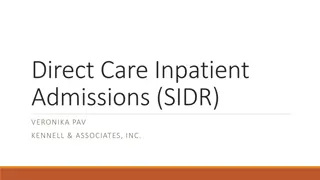WHY THE DRGs ARE NOT WELCOME IN COLOMBIA
Diagnosis-related groups (DRGs) face significant challenges in Colombia, with only a small proportion of high-complexity hospitals adopting this classification system. The study explores factors influencing the low implementation rate of DRGs in Colombian healthcare settings, emphasizing the need for further research and strategies to promote their uptake.
Download Presentation

Please find below an Image/Link to download the presentation.
The content on the website is provided AS IS for your information and personal use only. It may not be sold, licensed, or shared on other websites without obtaining consent from the author.If you encounter any issues during the download, it is possible that the publisher has removed the file from their server.
You are allowed to download the files provided on this website for personal or commercial use, subject to the condition that they are used lawfully. All files are the property of their respective owners.
The content on the website is provided AS IS for your information and personal use only. It may not be sold, licensed, or shared on other websites without obtaining consent from the author.
E N D
Presentation Transcript
WHY THE DRGs ARE NOT WELCOME IN COLOMBIA Yuri Gorbanev; Ariel Cort s; Sandra Agudelo y Francisco J. Yepes Pontificia Universidad Javeriana, Colombia.
http://www.ethik.uzh.ch/ibme/forschung/drg/drg.gif Diagnosis-related group (DRG) is a system to classify hospital cases into groups. Its intent was to identify the "products" that a hospital provides. One example of a "product" is an appendectomy. The system was developed to replace "cost based" reimbursement that had been used up to that point in US health care system. DRGs are assigned by a "grouper" program based on ICD (International Classification of Diseases) diagnoses, procedures, age, sex, discharge status, and the presence of complications or comorbidities.
INTRODUCTION Innovation Theory of diffusion of innovation (Rogers, 2003) suggests that successful adoption of an innovation depends on its attributes: relative advantage, compatibility, complexity, testing capacity and observability. The organizational theories explain the adoption of innovation by the structure and culture of an organization. The environmental theories explains the adoption of an innovation by the sociopolitical and economic context.
INTRODUCTION Figure 1. High Complexity Hospital with DRGs in Colombia, 2014 Although DRGs are not an innovation in Europe or US, them actually do for Colombia Only eight of 50 high complexity hospitals have it.
Our big challenge Very low implementation proportion of DRGs* in colombian hospitals. (Eight out of 50**) http://www.importancia.org/wp-content/uploads/don-quijote-de-la-mancha-en-la-literatura-370x232.jpg *Diagnosis Related Groups **High Complexity Hospitals
Figure 2. The model of managed competition in the Colombian healthcare system Ministry of Health and social protection http://www.biomedcentral.com/content/figures/1472-6963-10-297-1.jpg Vargas et al. BMC Health Services Research 2010 10:297
INSTRUMENTS AND METHODS It was an exploratory qualitative study that used a case method. We made a pilot study to validate the interview guide. We identified purposeful sample of key informants. The positive and negative aspects with relation to innovation were identified as well as the cultural aspects and the relationship among them.
Informants Table 1. Hospitals participanting in the study Total WITH DRGs WITHOUT HOSPITAL DRGs 6 Public Private 0 2 1 3 We only could capture data from these 6 institutions, because DRG s and HIS in Hospital Directors agenda were not a priority
Results We found two types of constraints: Institutional aspects: health care system Organizational aspects: hospitals http://static2.todoereaders.com/wp-content/uploads/2015/02/Don-Quijote-de-la-Mancha.jpg
Relative advantage Directors know DRGs allow to combine clinical performance and cost considerations. Improve clinical performance and quality of care, reduce the variability of medical practice, make staff performance transparent, helps to enforce the clinical practice guidelines and monitor the prescription of generic medicines rather than branded ones. DRG can help to get accreditation. Potentially, GRD can make negotiations between insurers and providers more transparent and evidence based because allows to compare the performance of the hospital with national and international practice.
Cultural compatibility DRGs are result oriented but, management indicators in Colombian hospitals and the health system in general are process oriented. (This occurs despite the evidence that good processes in health care do not ensure good results) Directors thought DRGs threatens physician autonomy.
Complexity There is a need of special training for doctors because they perceived DRGs as difficult to use. Managers do not consider DRGs as an autonomous program but as a module of ERP used in their hospitals. For Colombian medical doctors are essential to record the procedure because the procedure is billed. The main difficulty lies in the requirement of a detailed and correct record of diagnosis according to ICD10. Another obstacle to good reporting is the specific classification for procedures used in Colombia. (CUPs)
Testability The acquisition process of DRGs also appears as a complex matter. Managers consider DRGs as a system that cannot be tested before purchasing and implementation. The interviewees seemed interested to do so but no provider offered such a possibility.
Observability Managers agree that the observability of DRGs reports is not automatic. DRGs performance to the level of an individual doctor, but the management chooses not to do so for fear of harming the organizational climate. allows keeping track of the
Figure 2. Institutional determinants of DRGs implementation process Lack of competition on health market DRGs help get accreditation Relative advantage Compulsory reporting is based on process, not results Complexity DRGs need helpful public policy Compatibility DRGs makes Insurer Provider negotiation transparent, provides common language DRGs need correct provider strategy Testability Observability Positive Effect Negative Effect
Figure 3. Organizational determinants of DRGs implementation process DRGs help to accreditation DRGs need correct Coding Relative advantage DRGs help to control costs DRGs reduce VMP Complexity DRGs as a module of ERP DRGs reduce physician autonomy Physicians need training to work with DRGs Compatibility DRGs are result oriented Testability DRGs help to improve quality Observability Non conflict culture. *VMP: Variability in Medical practice *ERP: Enterprise Resource Planning Positive Effect Negative Effect
CONCLUSION Interviewees have positive perception of DRGs. DRGs allows to control for quality and costs simultaneously, they help to get accreditation, reduce VMP, potentially, may make negotiation between Insurers and Providers transparent. But the managers, who want to adopt DRGs, face organizational and institutional restrictions. Among organizational restrictions are: the culture of physician autonomy, non conflict culture, sub record of diagnosis and emphasis on process instead of results. Among the institutional restrictions are: lack of competition on the health care market, the negotiation between Insurers and Providers based on procedures not diagnosis and finally lack of public policy aimed at DRGs adoption.
!Thank you! Further information: sandra.agudelo@javeriana.edu.co sandragesis@gmail.com
Bibliography Ministerio de Protecci n Social; Universidad Nacional; FEDESALUD. Ranking de Instituciones Prestadoras de Servicios de Salud basado en el sistema nido de habilitaci n. Bogot : Ministerio; 2006. Greenhalgh T,GRFMPBOK. Diffusion of innovation in service organizations: Systematic review and recommendations. Milbank Quarterly, v. 82, No. 4 (Ebsco). 2004;: p. pp. 581 629. Fleuren M, Wiefferink K, Paulussen T. Determinants of innovation within health care organizations. Literature review and Delphi study. International Journal for Quality in Health Care. 2004; 16(2): p. 107 123. Rogers E. Diffusion of innovations New York: Free Press; 2003. Greenhalgh T, Robert G, MacFarlane F, Bate P, Kyriakidou O. Diffusion of innovation in service organizations: Systematic review and recommendations. Milbank Quarterly. 2004; 82(4): p. 581 629. Schein E. Organizational culture and leadership New York: Wiley; 2010. Mathauer I, Wittenbecher F. Hospital payment systems based on diagnosis-related groups: experiences in low- and middle-income countries. Bulletin of the World Health Organization. 2013; 91(10): p. 746-756A. Geissler A, Scheller-Kreinsen D, Quentin W. Do Diagnosis-Related Groups Appropriately Explain Variations in Costs and Length of Stay of Hip Replacement? A Comparative Assessment of DRG Systems across 10 European Countries. Health Economics. 2012; 21(Supplement 2): p. 103-15. Thommen D, Weissenberger N, Schuetz P, Mueller B, Reemts C, Holler T, et al. Head-to-head comparison of length of stay, patients' outcome and satisfaction in Switzerland before and after SwissDRG-Implementation in 2012 in 2012: an observational study in two tertiary university centers. Swiss Medical Weekly. 2014; 144: p. 1-10. Kroneman M, Nagy J. Introducing DRG-based financing in Hungary: a study into the relationship between supply of hospital beds and use of these beds under changing institutional circumstances. Health Policy. 2001; 55(1): p. 19-36. Ridder H, Doege V, Martini S. Hospitals on the road to competitive advantage? The case of implementing DRG in German hospitals. Academy of Management Annual Meeting Proceedings. 2005;: p. B1-B6. Ridder H, Doege V, Martini S. Differences in the Implementation of Diagnosis-Related Groups across Clinical Departments: A German Hospital Case Study. Health Services Research. 2007; 42(6): p. 2120-2139. Gorbanev I, Cort s A, Agudelo S, Torres S, Yepes F. Percepciones del personal hospitalario sobre la preparaci n institucional para la implementaci n de innovaciones en el sector salud. Universitas Medica, V. 53, No. 4. 2012;: p. pp. 352 - 364. Ridder H, Doege V, Martini S. Academy of Management Annual Meeting Proceedings. 2005;: p. B1-B6.






















